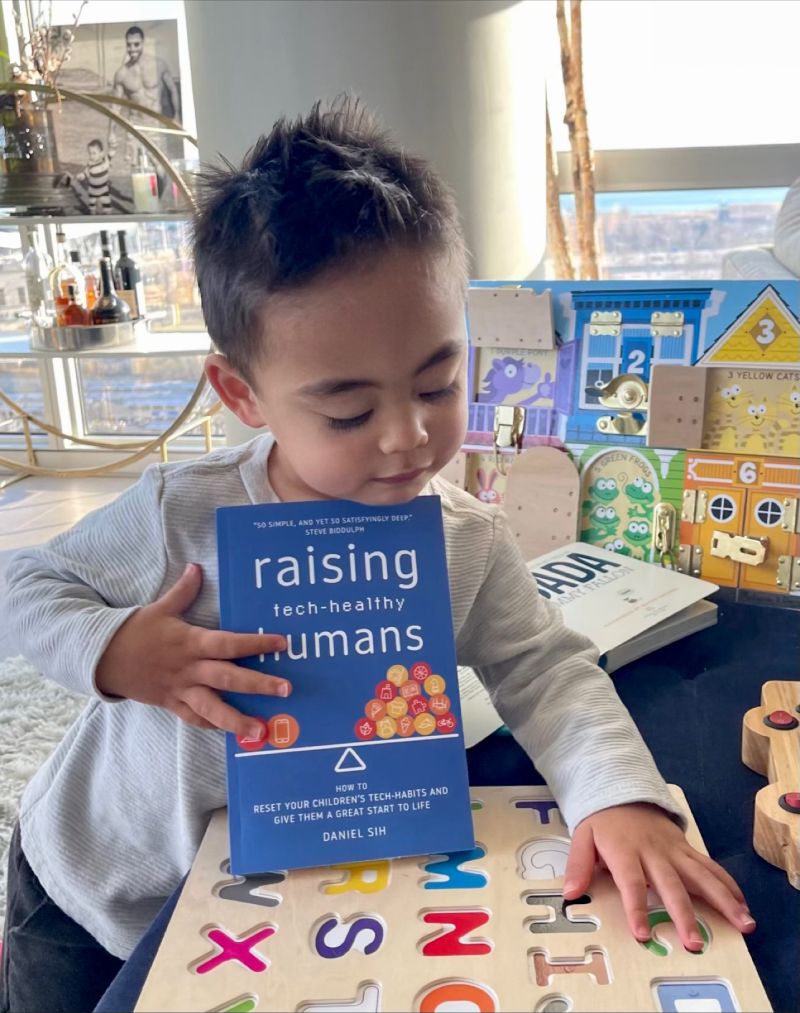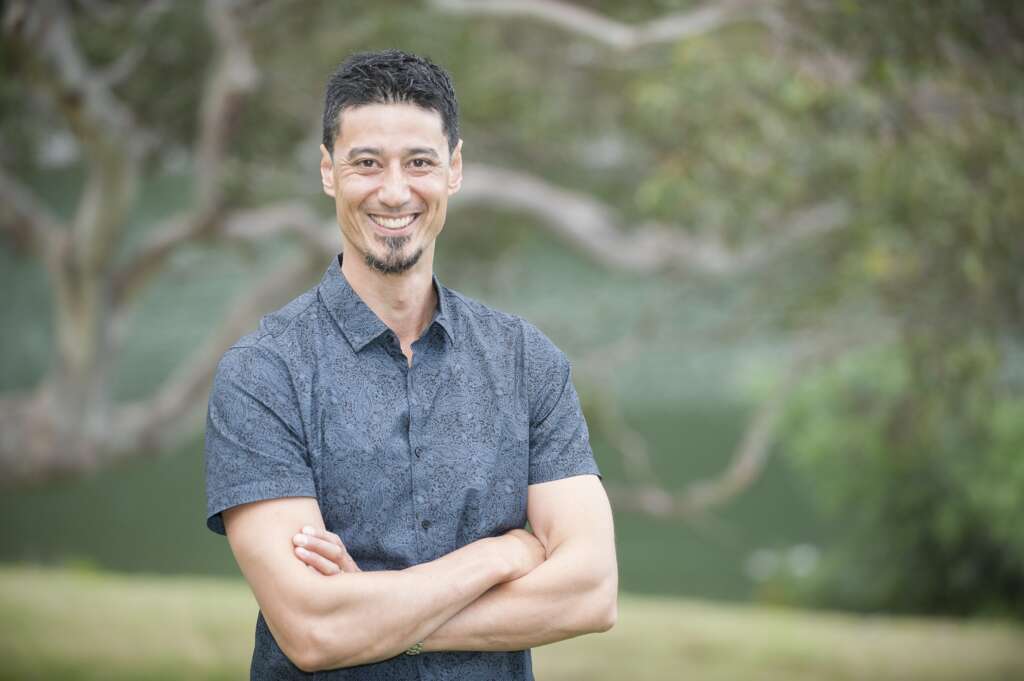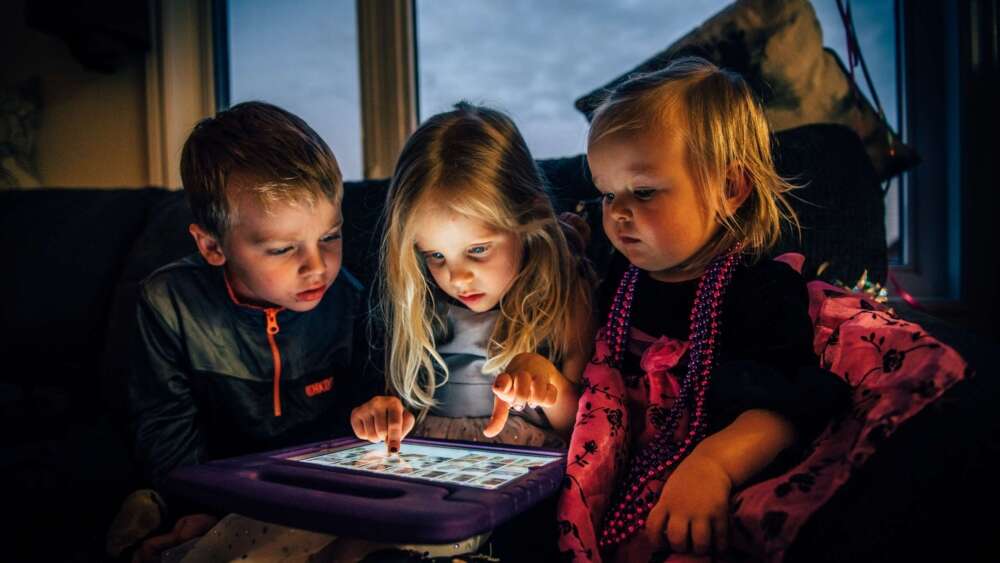After my mother had surgery to remove part of her lung due to tuberculosis, a nurse on the recovery ward gave her a cigarette to make her cough and clear her lungs.
It’s an anecdote that makes people today cringe, but back then, in the 1950s, smoking was so ubiquitous that even hospitals provided ashtrays to patients. Doctors lit up in surgical rooms and nurses featured in smoking ads.
When we look back, it’s hard to understand how people could have been so ignorant of the dangers of smoking, writes Daniel Sih in his latest book, Raising Tech-Healthy Humans. Surely the signs were there, even if not conclusive. But social pressure is powerful and smoking feels good in the moment.
“When future generations look back at how we gave iPads to toddlers, I do wonder whether we will shake our heads in a similar way,” the technology specialist writes in his brilliantly helpful new book.
“We are already aware that the steady rise in mental health disorders in young people – including anxiety, depression and self-harm – is in lockstep with the widespread uptake of interactive media. Might it be possible then for future generations to look back in disbelief and ponder, ‘How did they not see the connection?’”
 Speaking to Eternity this week about his principles for going slowly on giving mobile phones to children and protecting their developing brains from the damaging effects of interactive media, Daniel hastens to add that he doesn’t want his book to make parents feel guilty.
Speaking to Eternity this week about his principles for going slowly on giving mobile phones to children and protecting their developing brains from the damaging effects of interactive media, Daniel hastens to add that he doesn’t want his book to make parents feel guilty.
“Parenting is hard. I realise that, and it’s not meant to be a book that makes you feel guilty. It’s meant to be a book that hopefully empowers people with ideas … because the last thing parents need is more guilt and more stuff that they have to do,” says the Tasmanian-based author.
“The big heart of my book is that it’s not about cyber safety and it’s not about technology. It’s not about screen time. It’s about the beauty of raising healthy, faithful, loving humans. And to put all of that in the context of the vision we want for our kids, for ourselves and for our communities.”
“They have a significant impact on the kids’ internal development and their spiritual development and their heart development.” – Daniel Sih
A sequel to his first book Spacemakers, which showed adults how to tame the iPhone and claim back space to rest, think, plan and breathe, Raising Tech-Healthy Humans was originally aimed at parents of children aged five to 12. But in conversations over the past few months and delving deeper into the research, Daniel has realised that by the time kids are five, they’re already addicted to their devices because parents are giving iPads at age one.
So what’s wrong with that? According to Daniel, it’s as dangerous to give an adult tool, such as an iPad or an iPhone, to a toddler as it is to give a chainsaw to an eight-year-old boy.
“This is where we need education about the difference between different technologies. The analogy that I give in the book is that I once taught my young son, who was about eight or nine years old, to use a chainsaw because he was watching me chainsaw wood and I saw his curiosity, so I thought, ‘Oh, let him have a go.’ I set him up and showed him how to use it safely, put all the equipment on him and turned on the chainsaw, and he tried to cut some wood, but he couldn’t do it. It terrified him because he wasn’t strong enough. It was really dangerous,” admits Daniel.
“And I just realised, ‘Oh, a chainsaw is an adult tool designed for the adult world, and it’s not appropriate for a little kid.’ And when I look at the iPhone, the iPad, tablets and smartphones and how they’re designed, they are absolutely adult tools designed for the adult world, with adult power and they’re not appropriate for kids in the same way. It doesn’t damage their physical safety like a chainsaw, so we think they’re just fun things for kids. But they have a significant impact on the kids’ internal development and their spiritual development and their heart development.
“We really need to be thoughtful about when and how we give our kids these tools. So a lot of the book is about not just slowing down, but giving modified devices when they do get them so that they’re safer and much more child appropriate and then grading up as they grow up.”
“It’s all completely designed to make money, and so we have to be really thoughtful in introducing too much lean-forward technology at a young age.” – Daniel Sih
One of the surprises for me in the book was the concept of lean-forward and lean-back technology, in which blobbing out in front of the television is more benign than playing an interactive video game, which we think is educational.
“Any interactive media where you are swiping on a screen and you are changing the story –basically new media like tablets and phones – is quite different because you are leaning forward, engaging in it and it looks like you’re learning. But in actual fact, most of the time, the apps have been designed to ramp up the deep part of the brain, which we might call the old brain or the lizard brain. This is the fight, flee or freeze part of the brain, which is a very emotional part that doesn’t develop thinking and creativity and patience and kindness – all the things that make us faithful humans,” Daniel explains.
“Whereas with lean-back technologies, like the old television screen or even Disney Plus or Netflix, you are passively receiving content. And even though it’s highly engaging and at the end of each episode, you are addicted because you want to see the next episode, it still doesn’t seem to have the same impact on a young brain as the lean-forward stuff because it doesn’t dilate your eyes and put you into fight and flight, and it doesn’t have all the cues that you see in these technologies like Minecraft and Fortnite and social media apps that are really designed to make you addicted.”

Daniel Sih
Daniel says the primary purpose of apps such as these is to make money for their developers by keeping you on your devices for as long as possible and so seeing more advertisements.
“Every one of these devices, including Gmail and things that seem like work-based tools, and including apps like Minecraft, which are designed to make you hide from monsters, there’s variable rewards. So you dig and dig and then find diamonds randomly, and you can get social cues when you play with others. It’s all completely designed to make money, and so we have to be really thoughtful in introducing too much lean-forward technology at a young age.”
As if that weren’t enough to worry about, there are real risks to eyesight from giving children handheld devices too early. “It’s got nothing to do with the blue light. It’s to do with how close their screens are to their eyes. So that’s another issue that you want consider as well, particularly if you are of Asian heritage or your parents have near-sightedness.”
At this point, you might be objecting that this all sounds like anti-technology Luddite stuff, except for the very good point that Silicon Valley CEOs are leaders in going slow in exposing their kids to the technology they develop.
“You don’t want to be an early adopter when it comes to technology and kids. You want to go slower than most parents around you, even in the church community usually. You don’t want to keep up with the Joneses because culture right now is way too fast in terms of the kids’ development. The speed of culture is being shaped more by consumer forces and by Silicon Valley tech companies who don’t have your kids’ best interests in mind when they’re recommending devices that they wouldn’t even give to their own kids.
“And so, if we’re going to take someone’s lead, we should follow the lead of the tech giants of Silicon Valley, whose kids don’t go to high-tech schools and who aren’t allowed to use interactive media and who aren’t given the games that their parents are designing because they know just how incredibly addictive they are.”
“The younger we give it to them, the less ability they have to filter those messages through the faith and the frameworks of Christ.” – Daniel Sih
Daniel believes the Church is putting its head in the sand on this issue.
“It’s hard to keep our children in the faith anyway, given the secular culture and the individualised culture that they grow up in. But the liturgy that trains them in secularism and in not believing in God and believing that the self is all there is and believing that freedom is doing whatever you want rather than self-sacrifice – all that training comes through the devices that we give them. And the younger we give it to them, the less ability they have to filter those messages through the faith and the frameworks of Christ,” he says.
Daniel pulls no punches when it comes to debunking the trend of giving mobile phones to children as young as seven from a misplaced sense of stranger danger.
“When I ask parents why they’re giving their kids phones – and the average age now is 7.4 years old when kids get phones in Australia – the number one reason parents give is that they want to keep their kids safe. They want to know where they are. They want them to be able to ring them if there’s danger or if they’re on the bus or if they’re away.
“It’s madness. I don’t have another word for it. You can give your kid a dumb phone if that’s really what you need with no internet. But the stats definitely show that the majority of danger happens through the internet. The average age of seeing pornography is now 11 years old and the ubiquity of pornography in young kids’ lives is unfathomable and the type of pornography they’re seeing and the impact on their lives is horrendous. Parents absolutely have no idea what’s going on in the world.
“I like what [professor of public health] Julianna Miner says that if you are not ready to talk about pornography with your kids, or they’re not ready to have a conversation, then they’re not ready to have a phone because as soon as you give them an internet-enabled device, you’re pretty much giving them porn.”
“The stats definitely show that the majority of danger happens through the internet.” – Daniel Sih
On top of that moral issue is the issue of cyber safety.
“There are all the issues of distraction and how it impacts their focus and their concentration, their moral goodness, let alone the actual physical dangers that occur through meeting strangers and a whole lot of other stuff. I’m not saying the world is completely safe and you should have no rules. The real dangers, from what I see, are mental health dangers, distraction dangers and a loss of self. And that’s much more dangerous than the risk of catching a bus most of the time.”
Daniel says a recent study showed that by the time the average American male reaches 21, he had done 10,000 hours of online gaming. That’s the magic number for mastery of any subject.
“So you can complete an undergraduate degree and a master’s degree in that time, you can learn a language, you can do almost anything. And yet most of our boys are learning how to re-spawn and shoot things and it’s a really different training ground; it’s a different imagination of what it means to be an adult. Falling down and re-spawning is not the same as falling off a bike or tripping over on the soccer field and getting up and starting again.
“Losing a video game is not the same as practising and training physically for months and then still winning or losing that game because the other team happened to have a better day or because sometimes you don’t have the dynamics to win. But all of that’s helpful for training, and resilience – the type of real-life resilience we get when we stretch our physicality or our moral goodness. So again, putting kids in situations with other real humans where they have to apologise and negotiate and share their toys and say sorry when they’ve done something wrong. It’s completely different from what you learn in the online world where can hide a lot of your mistakes, and no one really has to say sorry or reveal who you are in a deep way.
“I’m not saying the online world’s bad, but you won’t be able to train kids with the type of resilience and moral goodness, and the bravery and the ability to examine the inner life that you’ll get in the real world. And we really need to major on that.”
If you’re still with us at this point, Daniel offers some practical steps to ensure that parents are raising tech-healthy adults, not just tech-healthy children.
“I’m not saying the online world’s bad, but you won’t be able to train kids with the type of resilience and moral goodness, and the bravery and the ability to examine the inner life that you’ll get in the real world.” – Daniel Sih
What Daniel says about bringing up adults, not children, was a key insight for me, that parents want to bring their kids up to be kind, good, patient, self-controlled – all those fruits of the Spirit.
“We talk about the fruit of the Spirit – love, joy, patience, peace, kindness, humility, self-control. But for each fruit of the Spirit, there is something that Jesus does in us in a redemptive way as we allow him to change our minds and habits, usually through spiritual disciplines,” says Daniel.
“But from a brain development perspective, it’s fascinating reading the research about the integrated brain and realising that all of those functions – kindness, empathy, humility, patience – are functions of the upstairs brain, the prefrontal cortex and the cortex.
“And that’s what’s being underdeveloped when you overstimulate the other part of the brain. So there is a real sense as Christian parents, if we want to raise our kids to be not just healthy humans but healthy adults who love Jesus with the characteristics of Christ, then we need to be thoughtful in giving them experiences that stretch their moral muscles, not just their interactive screen muscles.”
There are so many things I love about this book. But one thing I appreciate greatly is that he doesn’t just leave parents hanging with good intentions in going slow on technology but gives 100 ideas for non-screen-based activities at the back of the book.
“Look, it’s harder, but we used to be able to raise kids without screens, didn’t we? So it can’t be impossible!”
Raising Tech-Healthy Humans by Daniel Sih is available here.
Email This Story
Why not send this to a friend?


